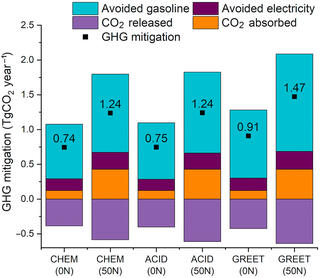Global warming intensity of biofuel derived from switchgrass grown on marginal land in Michigan
S. Kim et al. "Global warming intensity of biofuel derived from switchgrass grown on marginal land in Michigan" GCB-Bioenergy 15 (2023) [DOI:10.1111/gcbb.13024]
Energy crops for biofuel production, especially switchgrass (Panicum virgatum), are of interest from a climate change perspective. Here, we use outputs from a crop growth model and life cycle assessment (LCA) to examine the global warming intensity (GWI; g CO2 MJ−1) and greenhouse gas (GHG) mitigation potential (Mg CO2 year−1) of biofuel systems based on a spatially explicit analysis of switchgrass grown on marginal land (abandoned former cropland) in Michigan, USA. We find that marginal lands in Michigan can annually produce over 0.57 hm3 of liquid biofuel derived from nitrogen-fertilized switchgrass, mitigating 1.2–1.5 Tg of CO2 year−1. About 96% of these biofuels can meet the Renewable Fuel Standard (60% reduction in lifecycle GHG emissions compared with conventional gasoline; GWI ≤37.2 g CO2 MJ−1). Furthermore, 73%–75% of these biofuels are carbon-negative (GWI less than zero) due to enhanced soil organic carbon (SOC) sequestration. However, simulations indicate that SOC levels would fail to increase and even decrease on the 11% of lands where SOC stocks >>200 Mg C ha−1, leading to carbon intensities greater than gasoline. Results highlight the strong climate mitigation potential of switchgrass grown on marginal lands as well as the needs to avoid carbon rich soils such as histosols and wetlands and to ensure that productivity will be sufficient to provide net mitigation.
The agronomic inputs and fuel use data are obtained from the GLBRC Sustainability Data Catalog. Background information (SALUS simulation results, LCIs, electricity fuel mixes, and equation) is available on Dryad.
